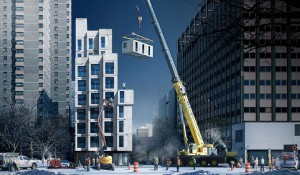Share This
Related Posts
Tags
New Kind of Cozy
By Cutright Elizabeth on Dec 28, 2015 in News
What can you get for less than 400 square feet? How about a gym, a roof terrace, stainless steel appliances and the chance to finally ditch the roommates and lay claim to your own slice of paradise. That’s the option currently being offered by Carmel Place, New Yor k City’s first ever micro-unit development.
k City’s first ever micro-unit development.
Originally called, “My Micro NY,” this Lower East Side building includes 14 affordable housing units and is set to open in February of 2016. Sitting smack dab in the middle of Kips Bay, the newly christened Carmel Place will be New York’s tallest modular building. Winner of the 2012 adapt NYC competition, which strove to uncover a solution to the City’s housing problem, Carmel Place came about through a collaborative effort between Monadnock Development and the Lower East Side People’s Mutual Housing Association.
The project’s designers, naArchitects, chose modular materials to reduce construction time, and a series of architectural flourishes make use of vertical spaces to create a sense of openness and light. Built in the Brooklyn Navy Yard and delivered by truck via the Manhattan Bridge, the nine-story Carmel Place apartments rise up on 333 East 27th street like a set of building blocks – gray in color, but multifaceted in the opportunities they promise to weary urban renters looking for a small space they can call their own.
Each unit comes outfitted with kitchenettes, mini-fridges, and a two-burner/microwave combination in place of a stove. While the bathrooms are restricted to showers only – no claw foot tubs in this joint – all the apartments are wheelchair accessible. The designers made sure to incorporate large windows, Juliette balconies and 9.5ft windows to create a sense of openness and light.
With hardwood floors and mostly white cabinetry, sample photos project a sense of tidiness and utility – no clutter allowed! In fact, Monadnock tapped Ollie and Resource Furniture to outfit the units with specially designed sofas, desks and Murphy beds. Tenants can also buy an “Ollie Box”, which includes additional décor options crafted to accent and accessorize the tiny dwelling, including throw pillows, rugs and table lamps all chosen for their ability to make the most of a small space.
Over 60,000 people applied for the 14 units priced at $950 to 1500 per month, and a lottery will determine which lucky New Yorkers will be able to claim their own 260 to 360 square foot apartment. Another 8 units have been set aside for homeless veterans.
Residents will not only have access to a gym, small garden and community room, the complex also includes a bicycle garage, a small lounge and plenty of tenant storage throughout the building. Residents will also have access to weekly housekeeping, Wi-Fi, cable and admission to certain events free of charge as part of their rental package. (Tenants of the affordable units can add the amenities package for an extra monthly payment though the units set aside for homeless veterans will include all the extra amenities).
Commenting on the number of applicants received for the affordable units, project developer Tobias Oriwol told the New York Times, “It shows the need that people feel for affordable, private space in the city.”
Though the hope is that these additional units will ease some of the City’s housing woes, it will ultimately be up to the market itself to determine the going rate for the development’s 12 market rate units.
Oriwol is confident prices will remain within reasonable ranges remarking, “The point of building smaller is to offer lower prices and the chance to escape roommates. People won’t just pay the same money for a smaller space.”
With the current rent listed for Carmel Place posted as $2,540 per month for the market rate apartments – about equal to the monthly rate of a standard Manhattan studio – those hopes for stabilized rents may die in the face of the City’s insatiable demand.
While the City’s current regulations prohibit apartments smaller than 400sqft, former Mayor Michael Bloomberg overruled those restrictions and allowed the project to move forward. Currently, the Department of City Planning is mulling a recent zoning proposal that would eliminate the 400sqft rule altogether to open the door for looser density restrictions and more micro-apartments.
Historically, micro-apartments are nothing new to the City. As the New York Times reports, almost 3000 apartments predate the city’s 1987 zoning restrictions, with many measuring less than 400 sq ft tucked away in converted hotels and prewar rooming houses.
According to the Citizens Housing and Planning Council, only 7% of New York City’s housing stock is made up of studios, while 40% of the City’s households are not families. That juxtaposition means that many single New Yorkers find themselves living with unrelated housemates, sometimes in illegal and unsafe configurations.
“There is this idea that bigger is better and that we need housing for families,” Sarah Watson, the deputy director of the Citizens Housing and Planning Council and manager of its Making Room initiative tells the New York Times.
“But people change, lifestyle changes, technology changes and the housing needs to change.”
